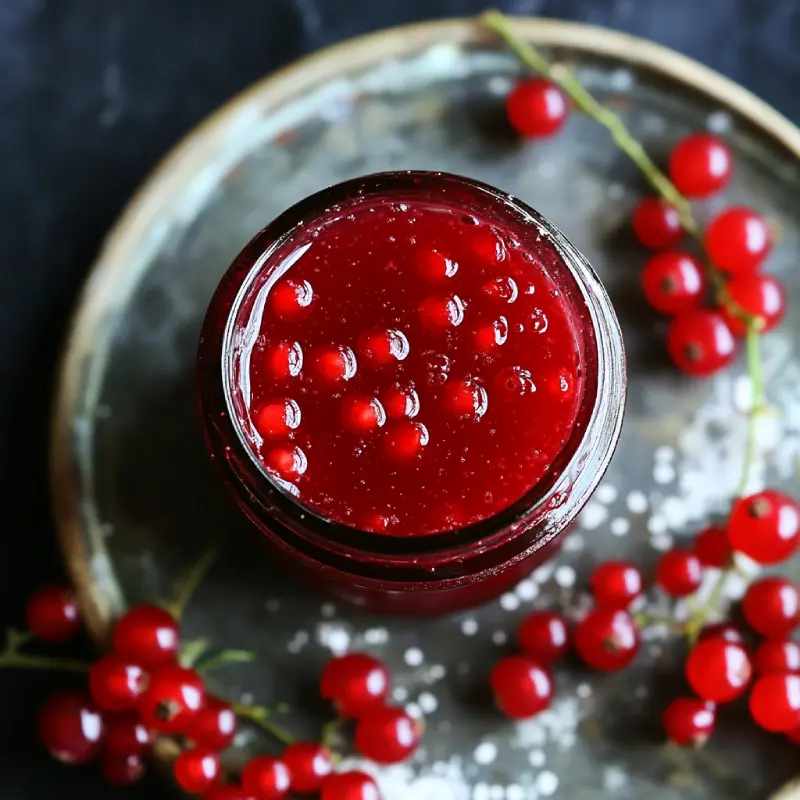Introduction to Red Currants in Polish Cuisine
Introduction to Red Currants (200 words)
Red currants are a staple in Polish cuisine, cherished for their vibrant color and tart flavor. These small, glossy red berries are integral to both sweet and savory dishes, ranging from jams and jellies to sauces and desserts. Historically, red currants have been cultivated across Poland, thriving in the temperate climate. Their seasonality peaks in mid-summer, making them a popular choice for midsummer festivals and traditional holiday dishes. In Polish culture, red currants are more than just a food item; they are a part of summer celebrations and family gatherings, often picked fresh from the garden or wild from the forests.
Health Benefits of Red Currants (200 words)
Red currants offer a range of health benefits, making them a valuable addition to any diet. These berries are rich in vitamins C and K, providing essential nutrients that support immune health and bone strength. Additionally, red currants are a good source of dietary fiber, which promotes digestive health and helps in maintaining a healthy weight. The antioxidants present in red currants, such as anthocyanins and flavonoids, contribute to heart health and may reduce the risk of chronic diseases. Their low calorie content makes them an ideal choice for a healthy snack or a natural sweetener in various dishes.
Classic Polish Red Currant Recipes
Red Currant Kompot Recipe (300 words)
Kompot is a traditional Polish beverage that offers a refreshing taste, especially during the warm summer months. Here’s how to prepare this beloved drink using red currants:
- Ingredients:
- 1 kg of fresh red currants
- 4-5 liters of water
- Sugar to taste (optional)
- Preparation:
- Start by washing the red currants thoroughly. Remove any stems or leaves.
- Place the cleaned red currants in a large pot and cover them with water.
- Bring the mixture to a boil, then reduce heat and let it simmer for about 15 minutes.
- Sweeten with sugar if desired, adjusting the amount based on your preference for sweetness.
- Strain the mixture to remove the fruits and then let the liquid cool. Serve chilled.
This kompot is not only a refreshing way to stay hydrated but also a fantastic method to preserve the summer fruit flavors for the entire year.
Red Currant Jam (300 words)
Making red currant jam is a wonderful way to capture the essence of Polish summers and enjoy the tart flavor of the berries year-round. Here’s a brief guide on how to make it:
- Ingredients:
- 1 kg of red currants
- Sugar (approximately 75% of the weight of the currants)
- Water
- Method:
- Clean the red currants thoroughly and remove the stems.
- In a large pot, combine the red currants with a small amount of water. Bring to a simmer and cook until the fruits break down.
- Add sugar to the fruit mixture and stir until dissolved.
- Continue to cook on low heat until the mixture thickens and reaches the desired consistency.
- Pour the hot jam into sterilized jars and seal.
These recipes highlight the versatility of red currants in Polish cuisine, offering both sweet and tangy flavors that can be enjoyed in various forms.
Modern Polish Recipes with Red Currants
Red Currant Meringue Cake (400 words)
The Red Currant Meringue Cake is a stunning contemporary Polish dessert that beautifully showcases the tartness of red currants with the sweet, fluffy texture of meringue.
- Ingredients:
- Fresh red currants
- Eggs (for the meringue)
- Sugar
- Vanilla extract
- Cream of tartar
- Preparation:
- Begin by preparing the meringue base using egg whites, cream of tartar, and sugar, whipping until glossy peaks form.
- Gently fold in vanilla extract for flavor.
- Spread a layer of red currants over the baked meringue base, adding a sprinkle of sugar to balance their tartness.
- Bake until the meringue is crisp and the currants have just begun to burst, releasing their juices.
- Decoration Tips:
- Top the cake with a light dusting of powdered sugar and a few whole red currants for a natural and elegant finish.
- Serve with a dollop of whipped cream or a scoop of vanilla ice cream to complement the tangy flavor of the currants.
Red Currant and Almond Tart (300 words)
This Red Currant and Almond Tart combines traditional Polish flavors with modern baking techniques to create a dessert that’s as delicious as it is visually appealing.
- Ingredients:
- Almond flour (for the crust)
- Butter
- Sugar
- Fresh red currants
- Eggs
- Method:
- Prepare the tart crust using almond flour and butter, creating a rich, nutty base that complements the tartness of the currants.
- Whip eggs and sugar together until light and fluffy for the filling.
- Spread the red currants evenly over the pre-baked crust and pour the egg mixture over them.
- Bake until the filling is set and the top is golden.
- Instructions for the Crust:
- Combine crushed almonds, a pinch of salt, and a little sugar with melted butter to form the dough.
- Press the mixture into a tart tin and bake until lightly golden before adding the filling.
These recipes reflect the evolution of Polish cuisine, embracing traditional ingredients like red currants while exploring new culinary landscapes through contemporary desserts.
Cooking Tips and Serving Suggestions
Cooking and Baking with Red Currants (300 words)
Red currants are a versatile ingredient that can add a burst of flavor and a pop of color to a variety of dishes. Here are some tips and advice on how to best prepare and use red currants in both cooking and baking:
- Preparation Tips:
- Always rinse red currants gently under cold water before using them to remove any dirt or debris.
- To destem the currants efficiently, hold a stem in one hand and run the tines of a fork down the length to separate the berries.
- Balancing Tartness:
- Red currants are known for their bright tartness, which can be a delightful contrast in sweet and savory dishes.
- For baking, pair red currants with sweeter fruits like raspberries or peaches to balance their acidity.
- In savory dishes, use red currants to create vibrant sauces for meats like duck or pork. Their tartness cuts through the richness of these meats beautifully.
- Cooking Techniques:
- When baking, consider adding red currants last to batters or gently folding them in to prevent them from breaking and bleeding too much into the mixture.
- For sauces or jellies, cook red currants with a touch of sugar and a splash of water to help them break down and release their natural pectins, which thicken the sauce.
- Serving Suggestions:
- Serve red currant compote or jelly as a condiment with cheese platters.
- Use fresh red currants as a garnish on desserts or cocktails for a touch of elegance and a hint of tartness.
FAQs and Conclusion
Frequently Asked Questions
- Can I substitute other berries for red currants in recipes?
- Yes, you can substitute red currants with berries like cranberries or raspberries for a similar tartness. Adjust sugar levels based on the sweetness of the substitute.
- How can I adjust the sweetness when cooking with red currants?
- If red currants are too tart, increase the sugar in the recipe gradually. Alternatively, honey or maple syrup can be used for a natural sweetness.
- Any tips for first-time cooks using red currants?
- Start with simple recipes like jams or sauces to get a feel for the flavor balance. Always taste as you go to adjust seasoning and sweetness according to your preference.
Conclusion and Encouragement to Experiment
Red currants are a wonderfully versatile ingredient in Polish cuisine, offering both nutritional benefits and a unique flavor that enhances a variety of dishes. Whether you’re making a simple jam or a complex dessert, red currants provide a distinct taste that can elevate your cooking.
I encourage you to experiment with red currants in your recipes. Adapt traditional dishes to suit your taste and explore new ways to incorporate this vibrant berry into your meals. Embrace the creativity that comes with cooking and enjoy the process of discovering new flavors!
This exploration can lead to delightful culinary creations that reflect both traditional and personal touches.

